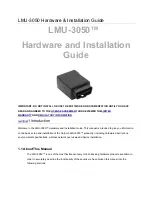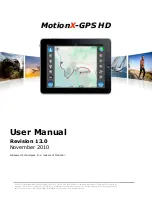
4.14. DRIVING METRICS (ACCELERATION, MAX. SPEED,
ETC)
situations. A vehicle having large acceleration values indicates unsafe an
expensive driving. On the contrary, low values indicate an smooth, efficient
driving. The actual acceleration of the vehicle can be known with the
XAIT
command. It could also be programmed to be reported by using
QXAIT
on
an event’s user-action field or by using an extended-EV reporting messages
which includes the acceleration value.
The
XAIT
command also gives information on the maximum positive ac-
celeration, maximum negative acceleration and maximum speed since the
last
Driving Metrics
reset. These values are stored along with the GPS in-
formation at the moment the maximum occurred (i.e. Date, time, position,
speed, heading). A
Driving Metrics
reset is performed by the user with the
same
XAIT
message. Notice that the unit could also be programmed to to
this automatically by adding the reset command on an event’s user-action
field. For example, the
Driving Metrics
can be reset any time the vehicle’s
ignition is turned off and after sending the
Driving Metrics
of the last trip.
The acceleration is measured in Miles per Hour per Second. This is, how
much the speed increases or decreases on a second basis. This means for
example that if a vehicle goes from 0 to 32mph in 4 seconds, the resulting
acceleration will be of 32/4 = +8 Miles/(h*s). When a vehicle breaks, the
resulting acceleration is measured in the same manner but it will be shown
as negative. Typical ’good’ values stay between -13 and +13, but what
are ’good’ and what are ’bad’ values is something that has to be determi-
nated by each client in a comparative manner between good and bad drivers.
Driving Metrics information is consulted (and reset) via the
XAIT
command.
See the TAIP chapter for detailed information. To query the actual driving
metrics resume, send to the unit:
>
QXAITR
<
The unit responds something like:
>
03+09-10,041;ID=EXAMPLE
<
This particular reading indicates that the actual acceleration is +3Miles/(h*s)
(or MPH*s), the maximum acceleration since the last
Driving Metrics
re-
set has been +9Miles/(h*s) and the maximum negative acceleration (maxi-
mum breaking) has been -10Miles/(h*s). The maximum registered speed is
41MPH.
Now, to know where the maximum breaking occurred, the GPS informa-
tion for the maximum negative acceleration is consulted:
>
QXAIT1
<
The unit responds something like:
>
RXAIT1-10EV001442578230-0802813901519512;ID=EXAMPLE
<
Showing the max. negative acceleration of -10 and adding the underlined
part which is an event 00
EV
message with all of the GPS information at
the moment the maximum breaking occurred.
To clear the maximum accelerations and maximum speed, the following
97
Содержание Antares SB
Страница 1: ......
Страница 2: ...Antares SB TM GSM User s Manual FW 5 21 Digital Communications Technologies April 15 2008...
Страница 37: ...2 1 POWER SUPPLY 35...
Страница 38: ...2 1 POWER SUPPLY 36...
Страница 42: ...2 5 CONNECTION DIAGRAMS 40...
Страница 141: ...6 Unit s TAIP reference...
Страница 191: ...6 32 XADM DIAGNOSTIC MESSAGE 189...
Страница 228: ......
Страница 229: ......
















































